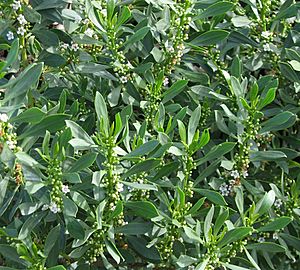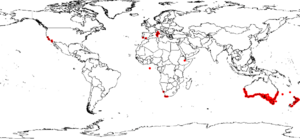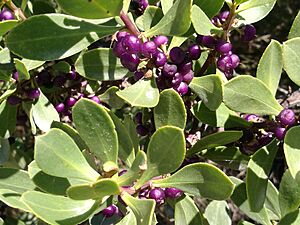Common boobialla facts for kids
Quick facts for kids Common boobialla |
|
|---|---|
 |
|
| Myoporum insulare at Black Rock, Victoria | |
| Scientific classification | |
| Genus: |
Myoporum
|
| Species: |
insulare
|
 |
|
| Occurrence data from GBIF | |
| Synonyms | |
|
List
|
|
The Myoporum insulare, also known as common boobialla or native juniper, is a cool plant from the figwort family. It grows naturally along the coasts of Australia. This plant can be a small bush or even a small tree. It loves growing on sand dunes and rocky cliffs near the ocean. It's super good at handling salty conditions! Because of this, many people use it in their gardens.
Contents
What Does Boobialla Look Like?
Boobialla plants can be different shapes. Some grow flat on the ground like a mat. Others stand tall like a small tree, reaching up to 6 meters (about 20 feet) high.
Leaves
Its leaves are thick and smooth, with a bright green color. They are usually 3 to 9 centimeters (about 1 to 3.5 inches) long. The leaves are shaped like an egg. Their edges can be smooth or have small teeth near the tip. Both the top and bottom of the leaves are the same dull green.
Flowers and Fruit
You'll see white flowers with purple spots on them. These flowers grow in groups of three to eight where the leaves meet the stem. Each flower is about 6 to 8 millimeters (about 0.2 to 0.3 inches) wide. They have five smooth, hairless sepals (small leaf-like parts under the petals). The petals form a tube, and the four stamens (the parts that hold pollen) usually stick out a little.
Boobialla flowers bloom at different times depending on where they are. In Western Australia, they flower from July to February. In southeastern Australia, they bloom from October to December. After the flowers, small, round fruits appear. These fruits are smooth and change from purple to black. They are about 4.5 to 9 millimeters (about 0.17 to 0.35 inches) wide.
How It Got Its Name
The plant Myoporum insulare was first officially described in 1810. A botanist named Robert Brown gave it its scientific name. The word insulare comes from Latin. It means "from an island," which makes sense because it grows a lot on coastal islands.
Where Boobialla Grows
You can find Myoporum insulare along the coasts of many Australian states. These include New South Wales, Victoria, South Australia, Western Australia, and Tasmania. It also grows on Lord Howe Island. It likes sandy soils, often growing among rocks or near sandstone.
Sometimes, this plant can spread to other places. It has become an invasive species in some parts of Africa and the western coast of the USA. In South Africa, it's known as manatoka.
Uses of Boobialla
Gardening and Landscaping
Common boobialla is a great plant for gardens. It grows quickly and can be used to make a hedge or a windbreak. It's strong and can handle coastal winds and dry weather. It's also easy to grow new plants from cuttings. Gardeners also use it as a base plant (called rootstock) for growing other types of plants, especially many Eremophila species.
Bush Tucker (Edible Uses)
The purple fruit of the boobialla plant is safe to eat. People sometimes use it to make delicious jams and jellies. However, it's important to know that in most parts of Australia, it's against the law to pick fruit from native plants in the wild.



